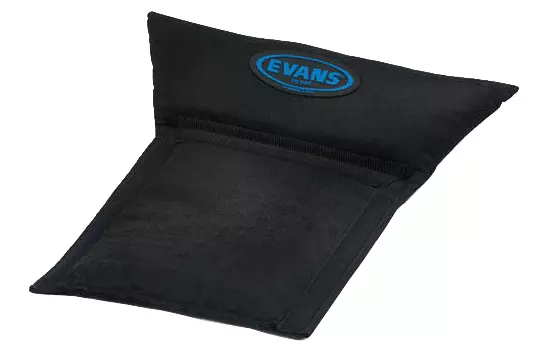Drum Muffling Part 2: Bass Drum Muffling

In many ways, bass drums define the sound of the drum kit. An appropriate tuning for a bop gig would be laughable for a metal session, and an open, “John Bonham” sound probably wouldn't work for folk music.
The diameter and depth of the drum, coupled with the heads selected, will determine the potential of the drum. Muffling, tuning and the player's touch will determine the actual sound that the drum produces.
Only you can determine the appropriate bass drum sound for the music you are making. However, it is good to experiment and learn how to modify the sound of your bass drum. You may be surprised by the range of sounds available to you without buying another kit.
No Muffling:
The biggest, loudest and longest bass drum note will come from a completely wide-open, un-muffled drum with a full (not ported) resonant head. Tuning of an un-muffled drum is critical, as small differences in tension can cause large effects on the overall sound of the drum. Relative tension differences between the batter and resonant heads can drastically change what both you and your audience hear.
Muffling and/or porting your drum will begin to add clarity to your bass drum notes, while incrementally reducing the overall volume. For drummers who play a lot of bass drum notes, or who use close mics or triggers, some muffling will be essential.
Porting:
Cutting a hole in the resonant head is commonly done to accommodate a microphone, but it also allows large amounts of air to exit the drum, and decreases the reaction of the resonant head. This will drastically reduce the sustain of the drum.
Although there isn't a wrong place to port a resonant head, cutting a hole in the centre of the head will eliminate almost all of its tone. If you want to maintain the most utility from the reso, you should make the hole 4 – 6” in diameter and a few inches in from the outside edge. Smaller holes allow more resonant tone, but may make microphone placement more difficult.
Felt Strips:
For a booming bass drum with just a hint of control, you may want to try using felt strips. Popular since the big-band era, felt strips are available from manufacturers such as Gibraltar, or you can simply make your own.
Check out these Gibraltar Bass Drum Felt Strips!
Muffling:
Adding blankets, pillows or your dirty laundry to the inside of the drum can muffle in three ways:
1. By contacting the batter and/or resonant heads and limiting their ability to transmit or reflect sound.
2. By taking up air space inside the drum.
3. By making the interior of the drum irregular, and thus less sound reflective.
A number of manufacturers make pillows specifically designed for bass drums, allowing you to keep the frilly throw cushions on grandma's couch, and keep the inside of your bass drum looking as “pro” as the outside.
Popular options include the Evans EQ Pad which is a great adjustable damper that is lightweight and low profile. Will a folded sweatshirt work as well? Maybe, but it won't look as good or be nearly as consistent in effect.
Check out this Evans EQ Pad Bass Drum Damper!
Pre-muffled Batter Heads:
Another popular option developed in recent years is the pre-muffled batter head. These heads incorporate rings of dampening material adhered to the inside or outside of the head.
Evans EMAD (Externally Mounted Adjustable Dampening) bass drum heads allow for three different levels of dampening (by adding or removing foam rings). The benefit is a drum that is consistently controlled with little or no extra material placed inside the drum, meaning you get muffling with maximum volume! Note: you cannot completely remove the dampening to achieve a wide-open sound when you want to.
Check out the Evans EMAD Batter Coated White Drumhead!
In Summary:
Luckily, experimenting with bass drum muffling can be relatively easy and inexpensive. Enjoy the process of figuring how muffling each head of the drum affects the sound. Go crazy and fill your bass drum with sofa cushions to see what it does, or try to get a great tone out of the drum with it completely empty...the range of sound available from a single drum is staggering. Take the time to learn how to get a full range of sounds from your bass drum.
Ultimately, your bass drum sound should be a conscious choice, not a random one. Having a sound that is appropriate to the music you're making is vital to the sound of your entire band.
Learning to tune your drums properly can be as much of a learning experience as learning to play them...and it is of equal importance to you and your audience!
* * *
Tony Bouma (“Tony B.”) is a drummer, martial artist and painter living in Southwestern Ontario. In his 25-plus years behind the kit, he has backed numerous rock, blues and country acts on local and regional levels. Tony works at Long & McQuade in Cambridge.









